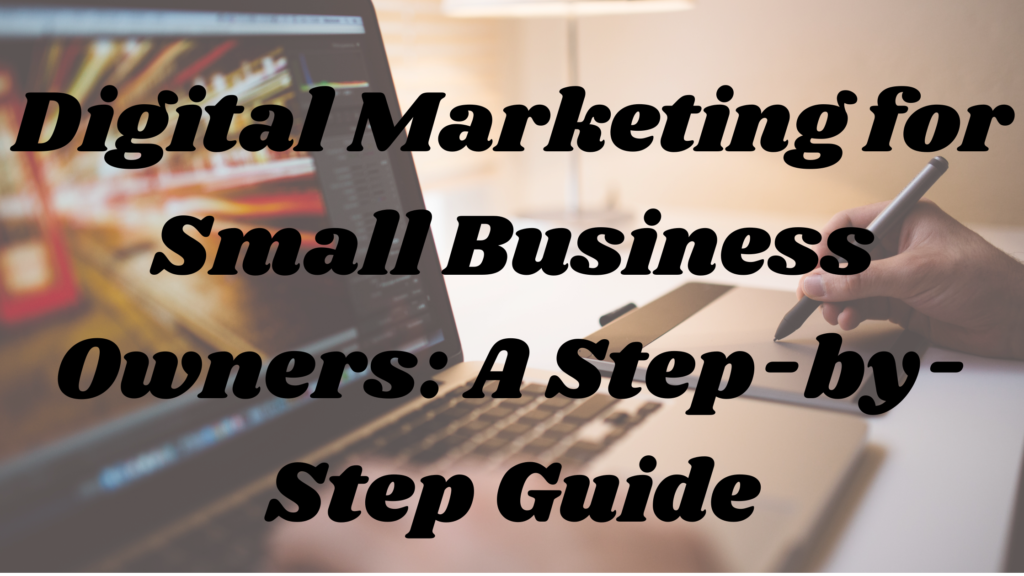Running a small business is no small feat. With the digital landscape evolving at breakneck speed, marketing can feel overwhelming. You’ve heard the buzzwords—SEO, PPC, social media marketing—but how do they all fit together? More importantly, how can you use them to drive real business growth?
This guide cuts through the jargon and gives you a clear, actionable roadmap to mastering digital marketing. Whether you’re starting from scratch or refining your strategy, here’s everything you need to know.
Step 1: Define Your Business Goals and Target Audience
Before you dive into digital marketing, you need clarity. What are you trying to achieve? More website traffic? Increased sales? Greater brand awareness? The answer shapes your strategy.
Know Your Ideal Customer
Your audience isn’t just ‘everyone.’ The more specific you get, the more effective your marketing becomes. Ask yourself:
- Who are my best customers? (Age, location, interests, spending habits)
- What problems do they have that my business solves?
- Where do they spend time online?
Understanding your target audience ensures that your marketing efforts aren’t just noise but a well-orchestrated strategy that speaks directly to potential buyers.
Step 2: Build a High-Performing Website
Your website is your digital storefront. If it’s slow, outdated, or difficult to navigate, you’re losing customers before they even learn about your business.
Essentials of a Business Website
- Speed: Your site should load in under 3 seconds.
- Mobile-Friendly: Over half of web traffic comes from mobile devices.
- Clear Call-to-Action (CTA): What should visitors do next? Book a call, request a quote, or make a purchase?
- SEO Optimized: Without SEO, your website is a needle in a haystack. Ensure it’s optimized with relevant keywords, fast-loading pages, and structured data.
If your website isn’t converting visitors into customers, it’s time for an upgrade.
Step 3: Master Search Engine Optimization (SEO)
SEO is your ticket to free, organic traffic. Unlike paid ads, which stop working when you stop paying, SEO keeps driving leads long-term.
SEO Basics for Small Businesses
- Keyword Research: Identify terms your audience is searching for.
- On-Page Optimization: Optimize headlines, meta descriptions, and content.
- Local SEO: Optimize Google Business Profile to appear in local searches.
- Backlinks: Quality links from reputable sites boost credibility and rankings.
SEO is a marathon, not a sprint. The earlier you start, the sooner you reap the benefits.
Step 4: Leverage Social Media for Growth
Social media isn’t just for cat videos. It’s a powerful tool to build brand awareness, engage customers, and drive sales.
Choosing the Right Platform
- Facebook & Instagram: Great for B2C businesses, e-commerce, and service-based businesses.
- LinkedIn: Ideal for B2B marketing and professional services.
- TikTok & YouTube: Perfect for businesses with a strong visual or educational component.
Pro Tips for Social Media Success
- Post consistently—three to five times per week.
- Use engaging visuals and short-form videos.
- Respond to comments and messages promptly.
- Run paid social media ads for targeted reach.
Step 5: Invest in Paid Advertising (PPC & Social Ads)
Paid advertising helps you cut through the noise and reach your target audience instantly.
Best PPC Channels for Small Businesses
- Google Ads: Perfect for targeting customers actively searching for your services.
- Facebook & Instagram Ads: Great for brand awareness and direct conversions.
- LinkedIn Ads: Ideal for B2B lead generation.
Quick PPC Tips
- Start with a small budget and scale as you see results.
- Use A/B testing to optimize ads.
- Focus on high-intent keywords.
Step 6: Email Marketing – Your Secret Weapon
Despite being one of the oldest digital marketing tools, email marketing remains one of the highest ROI strategies.
Building an Effective Email Strategy
- Collect Emails Ethically: Offer a lead magnet (e.g., free eBook, discount, or exclusive content).
- Segment Your Audience: Personalized emails perform better than generic ones.
- Automate Follow-Ups: Use email automation tools to nurture leads.
- Craft Compelling Subject Lines: Your email won’t matter if no one opens it.
A well-executed email strategy can drive repeat business and keep your brand top-of-mind.
Step 7: Measure, Analyze, and Optimize Your Strategy
Marketing without measurement is like driving blindfolded. You need to track performance to know what’s working.
Key Metrics to Monitor
- Website Traffic: Where are visitors coming from?
- Conversion Rate: How many visitors take action (purchase, sign up, etc.)?
- Customer Acquisition Cost (CAC): How much are you spending per new customer?
- ROI on Ads: Are your paid campaigns profitable?
Tools like Google Analytics, Facebook Pixel, and CRM dashboards help you make data-driven decisions.
Step 8: Stay Ahead with Continuous Learning
Digital marketing is constantly evolving. Algorithm updates, platform changes, and new trends can impact your strategy.
Ways to Stay Updated
- Follow industry blogs (Moz, HubSpot, Search Engine Journal).
- Join digital marketing communities and forums.
- Attend webinars and workshops.
- Experiment and adapt based on data.
Conclusion: Take Action Today
Small businesses that embrace digital marketing don’t just survive—they thrive. The key is consistency, adaptability, and a willingness to learn.
Start with one or two strategies from this guide and expand as you gain confidence. Whether it’s refining your website, mastering SEO, or running social ads, every step you take brings you closer to growth.
Need expert guidance? Our offshore digital marketing services can help you craft a results-driven strategy tailored to your business. Let’s take your brand to new heights!
FAQs:
1. Why is digital marketing important for small businesses?
Digital marketing helps small businesses reach a wider audience, compete with larger companies, and drive cost-effective growth. It allows businesses to build brand awareness, attract new customers, and increase sales without needing a massive budget.
2. How much should a small business spend on digital marketing?
There’s no one-size-fits-all answer, but a common recommendation is to allocate 5-10% of your revenue to marketing. If you’re just starting out, begin with a modest budget and scale up as you see results.
3. What are the most effective digital marketing strategies for small businesses?
The most effective strategies include SEO, social media marketing, paid advertising (PPC), email marketing, and content marketing. The right mix depends on your business goals and target audience.
4. How long does it take to see results from digital marketing?
It depends on the strategy. SEO can take 3-6 months to show significant improvements, while PPC and social media ads can deliver immediate results. Email marketing and content strategies often show impact within a few months with consistent effort.
5. Is SEO worth it for small businesses?
Absolutely! SEO helps you rank higher on search engines, making it easier for customers to find you organically. Over time, it reduces dependency on paid ads and drives long-term traffic.








Leave a Reply